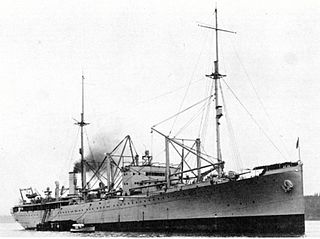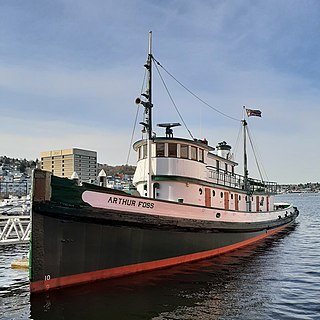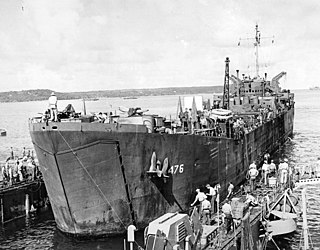
The Lake Washington Ship Canal, which runs through the city of Seattle, connects the fresh water body of Lake Washington with the salt water inland sea of Puget Sound. The Hiram M. Chittenden Locks accommodate the approximately 20-foot (6.1 m) difference in water level between Lake Washington and the sound. The canal runs east–west and connects Union Bay, the Montlake Cut, Portage Bay, Lake Union, the Fremont Cut, Salmon Bay, and Shilshole Bay, which is part of the sound.

Vigor Shipyards is the current entity operating the former Todd Shipyards after its acquisition in 2011. Todd Shipyards was founded in 1916, which owned and operated shipyards on the West Coast of the United States, East Coast of the United States and the Gulf. Todd Shipyards were a major part of the Emergency Shipbuilding Program for World War II.

Harbor Island is an artificial island in the mouth of the Duwamish River in Seattle, Washington, US, where it empties into Elliott Bay. Built by the Puget Sound Bridge and Dredging Company, it was completed in 1909 and was then the largest artificial island in the world, at 350 acres (1.4 km2). Since 1912, the island has been used for commercial and industrial activities including secondary lead smelting, shipbuilding and repair, bulk petroleum storage, metal fabrication and containerized cargo shipping. Warehouses, laboratories and other buildings are located on the island.

The first USS Pyro (AE–1) was an ammunition ship of the United States Navy, commissioned from 1920 to 1924 and from 1939 to 1946. Primarily operating in the Pacific Ocean, the Pyro was present during the Attack on Pearl Harbor.

Arthur Foss, built in 1889 as Wallowa at Portland, Oregon, is likely the oldest wooden tugboat afloat in the world. Its 79-year commercial service life began with towing sailing ships over the Columbia River bar, and ended with hauling bundled log rafts on the Strait of Juan de Fuca in 1968. Northwest Seaport now preserves the tug as a museum ship in Seattle, Washington.

Lockheed Shipbuilding and Construction Company, was a shipyard in Seattle, Washington with Yard 1 on Harbor Island and Yard 2 at what is now Jack Block Park at Seattle Terminal 5, both at the mouth of the West Waterway of Duwamish River. Yard 1 was founded in 1898 as the Puget Sound Bridge and Dredging Company, the company that built Harbor Island, and it was purchased by Lockheed in 1959. Yard 2 began operation in 1943 to build ships for the US Navy. The shipyard was permanently closed in 1988; Yard 2 was sold in 1989, and Yard 1 was sold in 1997, both to Port of Seattle.

USS Stein (DE-1065) was a Knox-class destroyer escort, later redesignated as a frigate (FF-1065) of the United States Navy. She was named after Tony Stein, the first Marine to receive the Medal of Honor for action in the Battle of Iwo Jima.
Lake Washington Shipyards was a shipyard in the northwest United States, located in Houghton, Washington on the shore of Lake Washington, east of Seattle. Today, the shipyards are the site of the lakeside Carillon Point business park. The shipyards built many civilian and U.S. Navy ships.

USS Plainview (AGEH–1) was, in its time, the world's largest hydrofoil. Named after the cities of Plainview, New York and Plainview, Texas, she was also the United States Navy's first hydrofoil research ship. Plainview was designed under project SCB 219; laid down 8 May 1964 by the Lockheed Shipbuilding and Construction Company, Seattle, Washington; launched 28 June 1965; sponsored by Mrs. John T. Hayward; and placed in service on 3 March 1969. She cost $21 million to construct.

The Auk class were a class of minesweepers serving with the United States Navy and the Royal Navy during the Second World War. In total, there were 93 Auks built.
USS Dextrous (AM-341) was an Auk-class minesweeper built for the United States Navy which served in World War II, the Korean War, and beyond. She was later transferred to the Republic of Korea Navy where she served as ROKS Koje (PCE-1003).

USS Oriole (AM-7) was a Lapwing-class minesweeper acquired by the U.S. Navy for the dangerous task of removing mines from minefields laid in the water to prevent ships from passing.
USS Spectacle (AM-305) was a steel-hulled Admirable class minesweeper built for the U.S. Navy during World War II. A trained crew boarded the new vessel, practiced with her minesweeping gear, and then proceeded to the Pacific Ocean to clear mines from Japanese beaches so that Allied forces could invade. While performing this dangerous task of mine clearance, a Japanese plane strafed her, and another deliberately crashed into her. When she returned to the United States, her battle damage was so severe that the U.S. Navy decided to scrap, rather than to repair, her. She was awarded two battle stars.

The Seattle-Tacoma Shipbuilding Corporation was an American corporation which built escort carriers, destroyers, cargo ships and auxiliaries for the United States Navy and merchant marine during World War II in two yards in Puget Sound, Washington. It was the largest producer of destroyers (45) on the West Coast and the largest producer of escort carriers of various classes (56) of any United States yard active during World War II.

Winslow Marine Railway and Shipbuilding Company was a shipyard in Puget Sound that operated from 1903 until 1959 on Bainbridge Island, Washington, United States.

USS LST-476 was a United States Navy LST-1-class tank landing ship used in the Asiatic-Pacific Theater during World War II.

The Type V ship is a United States Maritime Commission (MARCOM) designation for World War II tugboats. Type V was used in World War II, Korean War, and the Vietnam War. Type V ships were used to move ships and barges. Type V tugboats were made of either steel or wood hulls. There were four types of tugboats ordered for World War II. The largest type V design was the sea worthy 186-foot (57 m) long steel hull, V4-M-A1. The V4-M-A1 design was used by a number of manufacturers; a total of 49 were built. A smaller steel hull tugboat was the 94-foot (29 m) V2-ME-A1; 26 were built. The largest wooden hull was the 148-foot (45 m) V3-S-AH2, of which 14 were built. The smaller wooden hull was the 58-foot (18 m) V2-M-AL1, which 35 were built. Most V2-M-AL1 tugboats were sent to the United Kingdom for the war efforts under the lend-lease act. The Type V tugs served across the globe during World War II including: Pacific War, European theatre, and in the United States. SS Farallon, and other Type V tugs, were used to help built Normandy ports, including Mulberry harbour, on D-Day, 6 June 1944, and made nine round trips to Normandy to deliver Phoenix breakwaters.
Everett-Pacific Shipbuilding & Dry Dock Company was established in 1942 to build ships needed for World War II. Yard construction began on 1 March 1942. As part of the Emergency Shipbuilding Program the US Navy provided some of the capital to start Everett-Pacific Shipbuilding at Port Gardner Bay in Everett, Washington. Everett-Pacific was sold in 1945 to the Pacific Car and Foundry, who was already a major manufacturer of railcars and trucks. Pacific Car and Foundry was building barges for the US Navy during World War II at plants in Renton, Seattle and Tacoma in the state of Washington. The lease for the shipyard in Everett, Washington ended in 1949 and the yard closed. Pacific Car and Foundry in 1972 changed its name to Paccar Inc. to reflect its major products. The Everett-Pacific shipyard site later became part of Western Gear, a heavy machinery manufacturer. in 1987 the shipyard became part of Naval Station Everett. Everett-Pacific Shipbuilding was started by William Pigott Jr. a Seattle businessmen and his brother Paul Pigott (1900-1961). William Pigott Jr. was born in 26 Aug. 1895 in Pueblo, CO and died on 8 July 1947 in San Francisco, CA.

Captain John Laurentius Anderson was a preeminent figure in Washington state maritime industries in the first half of the twentieth century, particularly ferry service, shipbuilding, and ship-based tourism. He ran the largest ferry fleet on Lake Washington for three decades. He ran a large ferry fleet in Puget Sound. He built more than a dozen vessels at his shipyards, including the first ocean-going ship ever built on Lake Washington.

Naval Operating Base Terminal Island, was United States Navy base founded on 25 September 1941 to support the World War II efforts in the Pacific War. Naval Operating Base Terminal Island was founded by combining Naval Facilities in cities of San Pedro, Long Beach and Wilmington, California under one command. Much of the base was on the man-made Terminal Island, and harbor in San Pedro Bay. The harbor was made through the construction of a large breakwater system.
Denton Record Chronicle: October 4, 1924 - p. 4















